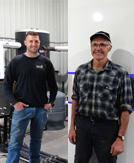Affordable heat for a cozy chicken coop
- Heating for Two Poultry Houses
4-foot residual logs, sourced from the client’s wood-cutting activities
4-foot residual logs, supplied by local loggers
Residual biomass, provided by other local farmers

« We’ve been raising chickens since 1960 and we decided to heat our poultry houses with biomass. By running on wood, we saved around 15,000 litres of propane from our first poultry production. The profit margin per production is definitely higher because of lower heating costs. »
Results
Ferme Boutin & Fils is located in St-Évariste-de-Forsyth, in Quebec’s Beauce region. This farm has a production capacity of 450,000 chickens per year.
“We heat two poultry houses with biomass. One of them measures 200’ x 60’ and the other, 225’ x 42’,” Jacques Boutin says, adding that the houses are two-storeys high.
“I raise the heat to 95°F, 24 to 48 hours before the chicks arrive so that the litter is as comfortable as possible. During the first two weeks, the temperature must remain constant, so we use a good amount of wood,” says Jacques.
The heat produced by the Sequoia boilers is distributed by the powerful Dragon Vert diffusers. The fuel comes from the farm’s vast wooded areas. Jacques and Jonathan Boutin also buy biomass from other suppliers at very good prices.
“Someone gave us 80 cords of spruce and cedar this summer,” says Jonathan. “It’s like receiving a gift of 50,000 litres of propane. At today’s prices, you have to admit, it’s a pretty big deal.”
Considering the savings generated by the Sequoia system, the farm owners now view their propane gas installations as auxiliary heating.
“With propane gas boilers, each poultry house was costing us around $25,000 a year to heat. In winter, the cost of propane could climb to $ 0.55 per litre. Subsidies are now available for biomass systems. Given the rising cost of propane gas, our project is paying off much faster than expected,” says Jacques.
But the Sequoia system offers benefits that go well beyond cost savings.
“The problem with brooding systems is that for every litre of propane burned, one litre of water is produced. Whether in the air or in the litter, there was a lot of humidity and this phenomenon created ammonia in our buildings. So, we had to change the air regularly, which meant expelling the heat outside to let the cold air in. With the Sequoia furnaces, we really see a difference in terms of bird comfort, air quality and litter quality. It’s really not the same,” says Jonathan. “It’s truly a plus for us.”







